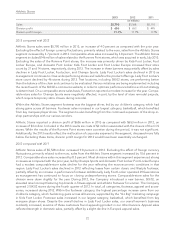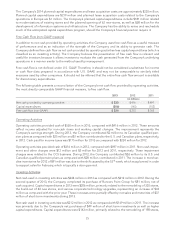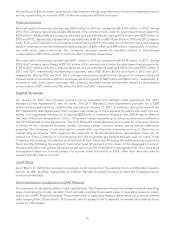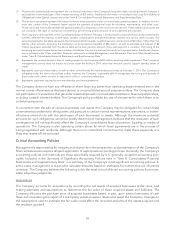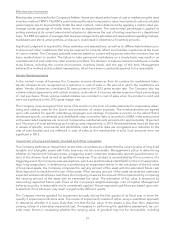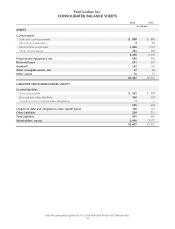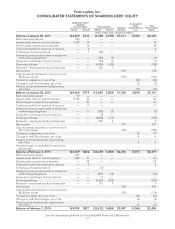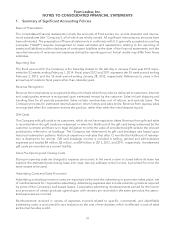Foot Locker 2013 Annual Report Download - page 54
Download and view the complete annual report
Please find page 54 of the 2013 Foot Locker annual report below. You can navigate through the pages in the report by either clicking on the pages listed below, or by using the keyword search tool below to find specific information within the annual report.
performance of those assets. The target asset allocation is selected to obtain an investment return that is suffi-
cient to cover the expected benefit payments and to reduce future contributions by the Company. The
expected rate of return on plan assets is reviewed annually and revised, as necessary, to reflect changes in the
financial markets and our investment strategy. The weighted-average long-term rate of return used to deter-
mine 2013 pension expense was 6.24 percent.
A decrease of 50 basis points in the weighted-average expected long-term rate of return would have increased
2013 pension expense by approximately $3 million. The actual return on plan assets in a given year typically
differs from the expected long-term rate of return, and the resulting gain or loss is deferred and amortized into
expense over the average life expectancy of its inactive participants.
Discount Rate — An assumed discount rate is used to measure the present value of future cash flow obligations
of the plans and the interest cost component of pension expense and postretirement income. The cash flows
are then discounted to their present value and an overall discount rate is determined. In 2011, the Company
changed how the discount rate was selected to measure the present value of U.S. benefit obligations from the
Citibank Pension Discount curve to Towers Watson’s Bond:Link model. The current discount rate is determined
by reference to the Bond:Link interest rate model based upon a portfolio of highly rated U.S. corporate bonds
with individual bonds that are theoretically purchased to settle the plan’s anticipated cash outflows. The dis-
count rate selected to measure the present value of the Company’s Canadian benefit obligations was
developed by using the plan’s bond portfolio indices, which match the benefit obligations. The weighted-
average discount rates used to determine the 2013 benefit obligations related to the Company’s pension and
postretirement plans were 4.32 percent and 4.20 percent, respectively.
Changing the weighted-average discount rate by 50 basis points would have changed the accumulated benefit
obligation of the pension plans at February 1, 2014 by approximately $30 million and $33 million, depending on
if the change was an increase or decrease, respectively. A decrease of 50 basis points in the weighted-average
discount rate would have increased the accumulated benefit obligation on the postretirement plan by approxi-
mately $1 million. Such a decrease would not have significantly changed 2013 pension expense or
postretirement income.
Trend Rate — The Company maintains two postretirement medical plans, one covering certain executive offic-
ers and key employees of the Company (‘‘SERP Medical Plan’’), and the other covering all other associates. With
respect to the SERP Medical Plan, a one percent change in the assumed health care cost trend rate would
change this plan’s accumulated benefit obligation by approximately $2 million. With respect to the postretire-
ment medical plan covering all other associates, there is limited risk to the Company for increases in health care
costs since, beginning in 2001, new retirees have assumed the full expected costs and then-existing retirees
have assumed all increases in such costs.
The Company expects to record postretirement income of approximately $2 million and pension expense of
approximately $20 million in 2014.
Income Taxes
In accordance with GAAP, deferred tax assets are recognized for tax credit and net operating loss carryforwards,
reduced by a valuation allowance, which is established when it is more likely than not that some portion or all
of the deferred tax assets will not be realized. Management is required to estimate taxable income for future
years by taxing jurisdiction and to use its judgment to determine whether or not to record a valuation allowance
for part or all of a deferred tax asset. Estimates of taxable income are based upon the Company’s strategic
long-range plans. A one percent change in the Company’s overall statutory tax rate for 2013 would have
resulted in a $5 million change in the carrying value of the net deferred tax asset and a corresponding charge
or credit to income tax expense depending on whether the tax rate change was a decrease or an increase.
The Company has operations in multiple taxing jurisdictions and is subject to audit in these jurisdictions. Tax
audits by their nature are often complex and can require several years to resolve. Accruals of tax contingencies
require management to make estimates and judgments with respect to the ultimate outcome of tax audits.
Actual results could vary from these estimates.
The Company expects its 2014 effective tax rate to approximate 36.5 percent, excluding the effect of any
nonrecurring items that may occur. The actual rate will vary depending primarily on the percentage of the
Company’s income earned in the United States as compared with its international operations.
31



